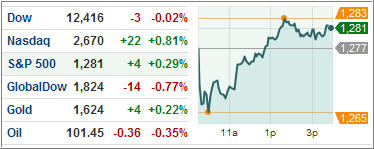Once again, major market ETFs didn’t move much as the S&P 500 gained 0.29%. But European indices fell once more while the Euro dropped to $1.28/Euro, its lowest level in 15 months.
While markets may not be fully incorporating European uncertainty at the moment, the weak Euro clearly indicates European concern among investors.
Although the VIX is relatively low just above 20, it’s no time to regain a risk appetite and move heavily into equity ETFs with the exception of a very select few. Volatility surely hasn’t faded away.
Widening European bond spreads also show continued financial strain in the region. Italy’s 10-year yield rose above the unsustainable 7% level to 7.07% while Spain’s 10-year yield went up to 5.59%. As borrowing costs remain high, confidence has greatly eroded. One thing’s for sure – I have little confidence that Europe can find a long-term solution without significant outside intervention.
In further signs of frailty amongst the PIIGS, the EFSF had to raise over $4 billion in funds to help Ireland and Portugal. Outside of the Eurozone, Hungary is falling into decline with worries that it might default this year based on its recent disappointing debt auctions. As Greece’s end is in sight, others are unfortunately starting to follow the same path.
Meanwhile, France’s bond auction today revealed persistent negative market sentiment. Not only was demand lower, but borrowing costs increased. Contagion has entered the European core and won’t be leaving any time soon.
Italy’s fortune isn’t getting any better as its unemployment rate edged up. Although nowhere near as dismal as Spain, it reveals the economic stagnation that Italy will have to endure in the years ahead in order to reduce its debt load.
An increase in U.S. payrolls is a promising sign ahead of tomorrow’s jobs figures although small businesses suffered a dip in employment in December. In the end, the unemployment rate will be the ultimate determinant of where the labor market is right now.
Known for having a high savings rate, China has finally come to realize that it needs to boost domestic consumption if it wishes to maintain strong growth. This is necessary for a more effective, self-sufficient global economy where countries don’t resort to currency wars to propel growth through exports.
Amidst the multitude of factors impacting ETFs, I’m especially looking forward to Friday’s unemployment numbers to see how markets respond. Until then, nothing’s going to change as far as our portfolio outlook is concerned.
Contact Ulli

Comments 4
Dear Ulli,
Your daily observations are very much appreciated as always. I know you have consistently advised caution in recent weeks, suggesting we mainly stay in bonds and cash. When I see all the green in your ETF signals, as in the latest, I get a bit confused. Basically you are saying that your technical signals (upward cross of the trend line by the TTI) have been selectively but widely on buy since 10/25, but that you are not following those signals. Is that right?
Thank you for your advice, and a Happy New Year to you and yours,
Mel
Mel,
The equity involvement for each investor is based on his risk tolerance. While I prefer a larger cash/bond position, I have also mentioned to pick selected sector/equity ETFs as per my Cutline reports. Yes, I agree with you that the markets have been confusing (due to the Feds manipulation efforts of interest rates), which has made this environment very challenging. For that reason, I’d rather lag a little in the equity department. I am not sure how long the domestic markets can decouple from the rest of the world.
Ulli…
Ulli, I just recently found your web site and have been following your current postings as well as looking back at archived material. I managed to avoid the steep downturns in the early 2000s and again in 2008, more to an abundance of caution than any real skill. I also missed out on a lot of the gains…same reason. I’m going to do some paper modeling of portfolios using your approach and if successful I’ll commit money. Naturally, I have had a number of questions and have been able to find answers to most of them in earlier posts. One remaining question is: what is the difference between the StatSheet and Cutline report and are they used differently? Thanks. Bob
Rob,
The Cutline reports merely show the percentages an ETF/mutual fund is positioned above or below its respective long-term trend line. Other than that, the data points are the same. In other words, it’s just a different perspective.
Ulli…